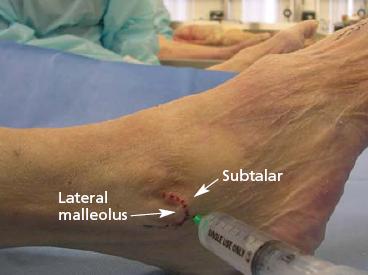Injection of the subtalar joint and sinus tarsi
ABSTRACT: Inflammation of the subtalar joint can make inversion and eversion of the foot uncomfortable. The pain of sinus tarsisyndrome implicates injury to the interosseous talocalcaneal ligament.This syndrome also may be associated with subtalar instabilityafter an inversion ankle sprain and may be seen in inflammatoryconditions of the foot and ankle. A lateral approach is preferred forinjection of the subtalar joint. For sinus tarsi injection, advance theneedle toward the medial malleolus. Infusing corticosteroid ¹/2 to 1 inch deep into the sinus tarsi increases the chances of success.(J Musculoskel Med. 2008;25:29-30)
ABSTRACT: Inflammation of the subtalar joint can make inversion and eversion of the foot uncomfortable. The pain of sinus tarsi syndrome implicates injury to the interosseous talocalcaneal ligament. This syndrome also may be associated with subtalar instability after an inversion ankle sprain and may be seen in inflammatory conditions of the foot and ankle. A lateral approach is preferred for injection of the subtalar joint. For sinus tarsi injection, advance the needle toward the medial malleolus. Infusing corticosteroid ¹/2 to 1 inch deep into the sinus tarsi increases the chances of success. (J Musculoskel Med. 2008;25:29-30)
The subtalar joint is a superficial joint formed by the articulation of the talus and the calcaneus. Inflammation can make inversion and eversion of the foot uncomfortable (as opposed to pain with dorsiflexion and plantar flexion in the true ankle joint). In inflammatory arthritis, the subtalar joint may communicate with the ankle joint and obviate the need for injection. Injection is challenging because this joint is small and difficult to access.
The sinus tarsi is a conical space on the lateral foot formed between the talus and calcaneus. It is enclosed by the extensor retinaculum and contains portions of the neighboring joint capsules and the interosseous talocalcaneal ligament. Injury to this ligament is implicated in the characteristic pain of sinus tarsi syndrome.
Sinus tarsi syndrome often is associated with subtalar instability after an inversion sprain of the ankle. It also may be seen in inflammatory conditions of the foot and ankle, including rheumatoid arthritis, ankylosing spondylitis, and gout.
Persistent pain resulting from inversion sprains of the anterior talofibular ligament-the principal lateral stabilizer of the ankle-may be confused with sinus tarsi syndrome. Alleviation of pain with injection of anesthetic may be diagnostic of sinus tarsi syndrome and help differentiate it from the pain of inversion sprains.
This article is the sixth in a 12-part series on the most frequently injected joints and bursae. Here we discuss injection of the subtalar joint and sinus tarsi.
Suggested supplies
• 3-mL syringe with 15 mg of prednisone equivalents (we prefer 10 mg of methylprednisolone for both the subtalar joint and sinus tarsi) and 1 mL of 1% lidocaine.
• A 25-gauge needle for the subtalar joint and a 1- or 1.5-inch 22-gauge needle for the sinus tarsi.
• Alcohol wipes, povidone-iodine, or chlorhexidine for sterilization.
• Local anesthetic: ethyl chloride topical spray or 1% lidocaine (optional).
• Needle cap or ballpoint pen to mark the site of insertion.
• Nonsterile gloves.
• Gauze pads and bandage.
Surface anatomy
• For injection of the subtalar joint, a lateral approach is preferred because visualizing and entering the joint with this approach is easier. Place a mark just inferior and posterior to the tip of the lateral malleolus. Estimation of the joint line may be further facilitated by putting the foot through inversion and eversion.
• To access the sinus tarsi, palpate and mark the soft recess just distal to the lateral malleolus on the foot.
Patient position
• For either injection, the patient should be asked to lie supine and try to be comfortable. To enlarge the sinus tarsi, the foot should be inverted.
Procedure
• Subtalar joint: After sterilization and application of local anesthetic, advance the needle at an angle perpendicular to the skin (See Figure 1 enlarged).

Figure 1 – An approach to subtalar joint injection is shown on a cadaver model. The point of entry is just inferior to the lateral malleolus.
Sinus tarsi: Advance the needle toward the medial malleolus (See Figure 2 enlarged). The needle will not meet bony resistance; therefore, once the needle is roughly ¹/2 to 1 inch deep, infuse the anesthetic and corticosteroid.

Figure 2 – An approach to sinus tarsi injection
is shown on a cadaver model.
Pearls
• Infusing corticosteroid ¹/2 to 1 inch deep into the sinus tarsi increases the chances of success. In addition, the risk of skin hypopigmentation is reduced.





